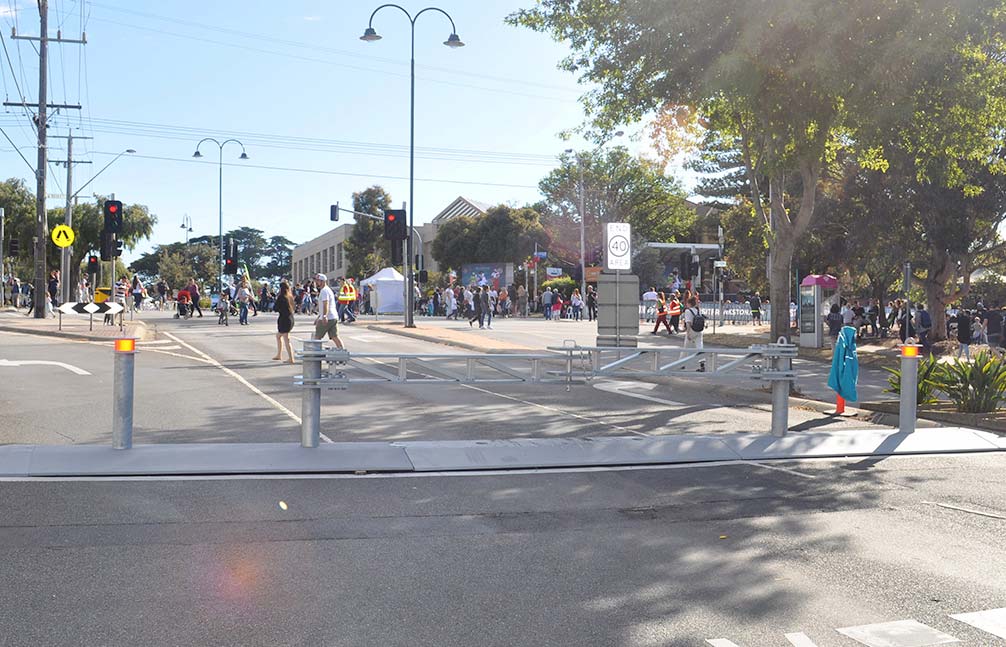Reasons Why You Need Bollards at Public Venues

The unsung heroes of traffic control and site security, we see security bollards (also known as pylons, barriers and columns) everywhere but don’t tend to pay them much attention. Available in different shapes and sizes, they serve a variety of different roles (such as managing vehicular traffic, blocking pathways and protecting buildings).
The simplest explanation of their purpose is that bollards are rooted in the ground to block vehicle access. They are typically evenly-spaced across the area in order to keep vehicles out whilst still allowing pedestrians, bicycles and prams to pass through with ease.
Barriers can, however, be a little more complex than this. Some are removable, which means they can be manually detached to allow temporary vehicle access. They can even be automatically activated using hydraulic or pneumatic pressure, allowing them to be raised and lowered as required.
But why exactly are bollards so important for public venues?
For protecting people
There can be no denying that an accident between a vehicle and a pedestrian can lead to serious injury or even death, so protecting people at all costs is a must. Clearly mapping out where pedestrian and where vehicular traffic should flow can help to prevent such accidents from occurring and keep everyone safe. On top of this, barriers can also help to create a seamless traffic flow with very few interruptions.
For traffic control and parking management
Congested parking areas can lead to a lot of wasted time and even money. The addition of security bollards can help to reduce this problem by guiding traffic through pre-determined routes and boundaries, clearly separating entry and exit lanes and marking the end of parking bays. Combined, these things will help to avoid cars entering the wrong lane or entering lanes the wrong way, as well as prevent drivers from taking shortcuts through the parking lot (which can lead to dangerous traffic situations).
For protecting parking asset infrastructure
The reality is that parking infrastructure maintenance and repairs can be costly. Think about everything that an underground parking garage contains, for example – concrete columns, elevator shafts, roller doors, gates, pipelines and more. Anytime a vehicle collides with them, even just a small bump, damage of some sort can occur. The installation of barriers is a very clear and simple way of preventing such damage from occurring. They can, for example, prevent drivers from unintentionally reversing into a concrete column or water main.
Bollards are also a big safety feature from a security perspective. Installing them adjacent to a walkway, for example, could save the life of a pedestrian in the event that a car loses control. In warehouse or industrial setting, on the other hand, they can be used to help separate pedestrians from hazard zones (such as where forklifts are operating), enhancing workplace health and safety.
For reserving disabled parking bays
An essential component of any parking lot, disabled bays must be easily accessible for those who really need them. This means that they must be wider, more visible and located closer to entry and exit points. Their prime location does, however, mean that disabled bays are often utilised by able-bodied people who don’t see the harm in taking up the spot for a couple of minutes or if no one else is currently using it. There is a variety of barrier systems that can reserve disabled parking bays for those who are meant to be using them.
For reserving your own parking bays
It can be incredibly frustrating when you arrive at your workplace first thing in the morning or at home after a long day at work only to discover that someone has parked in your spot. The result is unnecessary stress and wasted time in having to find somewhere else to park (hopefully not stealing someone else’s spot) or in having to track down the owner of the offending vehicle and ask them to move. The addition of security bollards to parking bays that you either rent or own outright can help to prevent this frustrating issue from occurring.
For expanding and reducing parking areas
Situations may arise when you need to either expand or reduce the area that is available for parking. During a sporting event, for example, you may want to use the parking lot to its absolute maximum capacity – including bays that are usually reserved and blocked off for employees and other VIPs. If some sort of damage has occurred to the upper level of a parking garage, on the other hand, you may want to restrict vehicle access to the lower levels so that they won’t interfere with the clean up.




